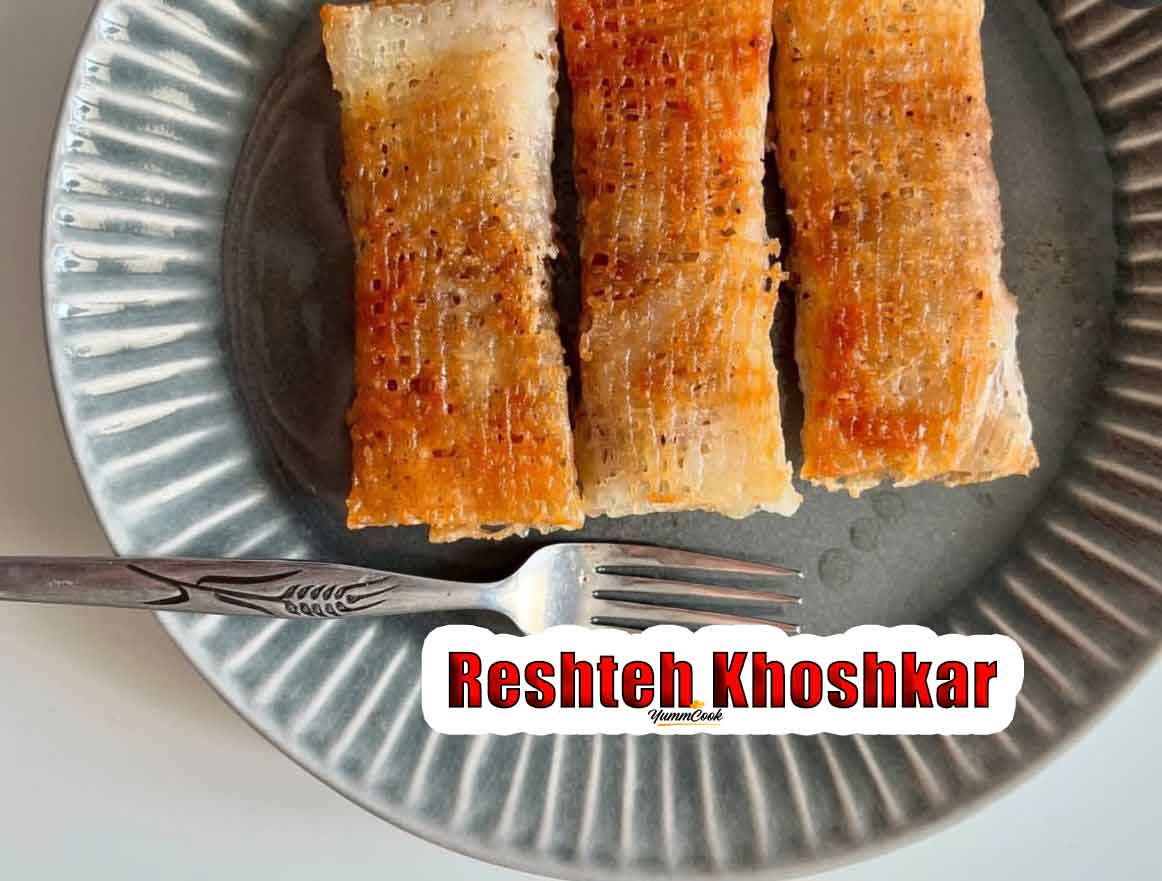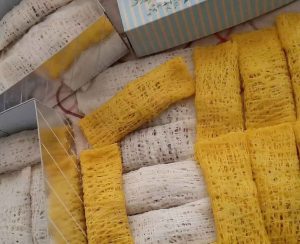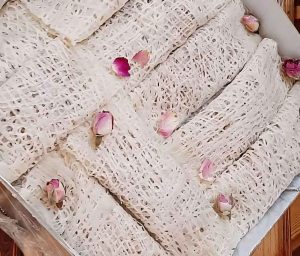Reshteh Khoshkar Recipe: Traditional Gilani Sweets

Khoshkar is one of the old and authentic sweets of Gilan that is baked in different cities. This fragrant, sweet treat is so popular and tasty that it can be a great treat with tea in any season and for any group. The combination of rice flour, walnuts, sugar, and aromatic spices gives Reshte Khoshkar a special taste that is completely different from other Iranian sweets. In this article, we are going to introduce you to how to make Khoshkar Gilani in a completely homemade and authentic way, a method that you can easily implement at home and make a colorful and tasty sweet.

What is Khoshkar?
Khoshkar is a traditional Gilani sweet that is made with “very thin strands of rice flour.” These strands are poured onto a teak or pan to form a thin and soft layer. These layers are then filled with a mixture of walnuts, sugar, and spices, folded, and finally fried. Famous sweets such as Baghlava and Ghottab also use these local ingredients, the recipes for which we have provided for you on this site.
This sweet is usually prepared widely in Rasht, Lahijan, Soumeh Sara, and Fouman, but it has its fans throughout Gilan. In the past, Reshte Khoshkar was mostly prepared during Ramadan and for iftar, but today it is known in many homes as an evening snack and even a souvenir of Gilan.

Ingredients for making Reshte Khoshkar (for 4 to 5 people)
| Fresh rice flour | 2 Cups |
| Water | About 3 cups |
| Salt | A pinch |
| Turmeric | 1/2 Teaspoon |
| Chopped walnuts | 1 Cup |
| Sugar | 1/2 Cup |
| Cinnamon powder | 1 Teaspoon |
| Cardamom powder | 1/2 Teaspoon |
| As much oil | As needed for frying |
| Grape juice or honey | To serve as desired |
How to make Gilani Khoshkar Reshteh at home
Step 1: Make the noodle dough
Be sure to sift the rice flour once until its texture is smooth. Then add water little by little and mix with a hand mixer. The consistency of the dough should be like “water”. Finally, add salt and turmeric and mix well.
Important note: If the rice flour is old or impure, the noodles will crack and tear. So, note that the rice flour must be fresh and of good quality.
Step 2: Prepare the Khoshkar dough
In a bowl, mix the chopped walnuts, powdered sugar, cinnamon, and cardamom. You can also add a little ginger powder if you like. The sweetness of the ingredients is completely optional and can be adjusted by adding or subtracting powdered sugar.
Step 3: Pour the dough onto the pan or griddle
Place the non-stick pan or griddle over low heat until it is just “warm.” Then pour the dough into a bottle with a perforated lid or a dropper. Pour the liquid onto the pan in a quick, circular motion in fine lines. The dough will set and dry very quickly. When the surface of the dough is dry and separates from the pan, gently remove it and place it on a cloth.
Step 4: Fold and fill
Pour about 1 tablespoon of the walnut kernels onto each layer of dough. Then gather the two sides and fold them into a samosa or semicircle shape. Press the edges together with your hands so that they do not open when fried. If the noodles are dry, place a damp cloth on them to soften them.
Step 5: Fry the Khoshkar
Heat the oil in a pan and drop the Khoshkars into the oil and fry only until they turn golden brown. Deep frying will make them hard. After frying, place them on a kitchen towel to absorb excess oil.
Step 6: Serve
You can eat Rashti sweets noodles with grape juice, which is the old and traditional method, or with a little honey. These two methods are excellent for people with diabetes.

Homemade Reshteh Khoshkar: Traditional Gilani Sweet
Ingredients
Method
- Prepare the Batter
- Sift rice flour into a bowl.
- Add water gradually and whisk until the batter becomes thin like water.
- Add salt and turmeric, then mix well.
- Tip: Batter must be thin so the strands come out smooth.
- Make the Nut Filling
- Mix chopped walnuts, sugar, cinnamon, and cardamom in a bowl.
- Adjust sweetness to taste.
- Cook the Rice-Flour Strands
- Heat a non-stick pan over low heat (just warm-not hot).
- Pour the batter into a bottle with a perforated lid.
- Drizzle thin strands quickly in circular motions onto the pan.
- Once dry and easily lifted, remove and place on a cloth.
- Fill and Fold
- Place 1 tbsp of walnut mixture on each sheet.
- Fold into a semicircle or samosa shape.
- Press edges to seal them well.
- Fry the Khoshkar
- Heat oil in a pan.
- Fry each Khoshkar just until golden (avoid over-frying).
- Transfer onto a paper towel to drain excess oil.
- Serve
- Serve warm with grape molasses or honey.
- Best enjoyed with Persian tea.
Important tips for making Khoshkar noodles
- Use fresh rice flour; stale flour will cause the noodles to crack.
- The batter should be thin; the thinner the noodles, the tastier the pastry.
- Do not heat the pan; too much heat will cause the noodles to burn.
- Do not pour too many intermediate ingredients; The large amount of ingredients causes the Rashti sweets to open up when fried.
- For a better color, some women add a few drops of brewed saffron to the batter.
Differences between Khoshkar in Rasht and other cities in Gilan
- In Rasht, the noodles are usually made very thin and uniform.
- In Lahijan and Fouman, more walnuts are usually used, and the pastry is slightly sweeter.
- In some more traditional regions, Khoshkar is dipped in thick syrup after frying and fried again; a method that makes the pastry softer and stickier.

Types of Reshteh Khoshkar
- Plain Khoshkar (without syrup)
- Khoshkar with traditional thick syrup
- Honey Khoshkar
- Nutty Khoshkar with more spices
- Market Khoshkar (harder and sweeter)
Benefits and nutritional value of Reshteh Khoshkar
- Good source of energy
The presence of flour, sugar, and walnuts makes Khoshkar an energy-giving snack, making it very suitable for breakfast, iftar or snack.
- Rich in beneficial fatty acids
The walnuts in Rashti sweets are an excellent source of beneficial fats that promote heart health.
- Contains natural antioxidants
The combination of walnuts, cinnamon, and cardamom provides a large amount of antioxidants and helps strengthen the immune system.
- Improves memory and concentration
Walnuts are rich in omega-3, and consuming Khoshkar can help support brain function, concentration, and memory.

Disadvantages and Precautions Khoshkar
- Not suitable for diabetics
Due to the presence of sugar and sweet nutrients, can increase blood sugar quickly and is not suitable for people with diabetes.
- High calories in the fried version
Frying Rashti sweets in oil increases its calories significantly; therefore, it is better to eat it in moderation.
- Caution for people with sensitive stomachs
If you have a sensitive stomach, it is better not to serve Rashti sweets with thick and very sweet syrups to avoid heaviness and digestive discomfort.

Conclusion
Rashteh Khoshkar is one of the most authentic Gilani sweets that can be easily prepared at home. Although preparing the string requires some skill, with a few practices you can make it in the best way. If you are looking for a colorful, tasty, and traditional homemade sweet, Rashteh Khoshkar (Wikipedia) is a great choice.
To learn more recipes for authentic Iranian and international dishes, you can visit the YummCook website.
